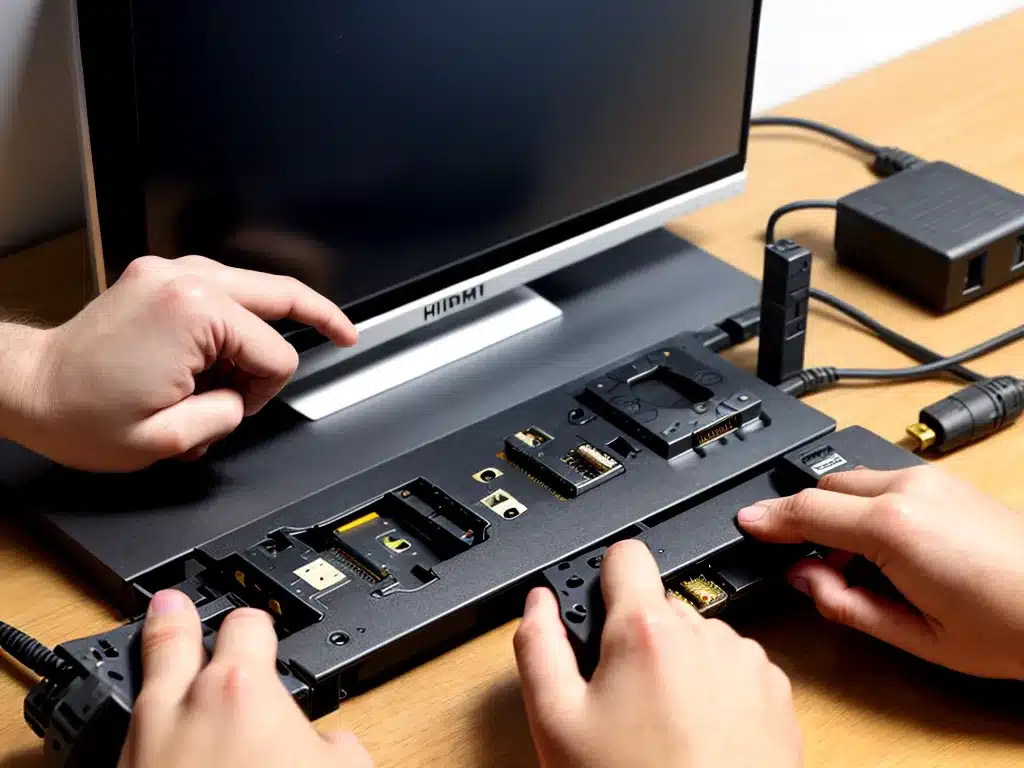
Connecting devices with HDMI cables is usually straightforward. However, sometimes HDMI ports stop working properly. As frustrating as that can be, there are several things you can try to get your HDMI ports functioning again.
Diagnose the Issue
The first step is to diagnose where the problem lies. An HDMI port not working could indicate an issue with the cable, the ports themselves, or a software/settings problem.
Check the HDMI Cable
Make sure the HDMI cable is not damaged or faulty. Examine the cable for any cuts, crimps, or bent pins. Try using a different HDMI cable that you know works. Faulty cables are a common cause of HDMI issues.
Try Different Ports
Test connecting the HDMI device to a different port on the TV or monitor. Also try using the other HDMI port on the device if there is one. This helps determine if the problem is with a specific port.
Update Drivers and Firmware
Outdated drivers and firmware can sometimes cause HDMI connectivity problems. Check for and install any updates available for the device, TV/monitor, and graphics drivers if applicable. Keeping firmware and drivers up to date can prevent compatibility issues.
Reset Devices
Resetting the source device and TV/monitor to factory default settings may help resolve software-related HDMI issues. After resetting, re-pair the devices and reconfigure HDMI settings.
Troubleshoot HDMI Ports
If you’ve determined the problem lies with the HDMI port itself, there are some ways to troubleshoot and attempt to fix it.
Check for Physical Damage
Carefully inspect the HDMI ports for any signs of physical damage like bent pins, dislodged connectors, or damaged housing. Damaged ports can prevent proper HDMI signal transfer.
Clean HDMI Ports
Buildup of dust, debris, and lint in the HDMI ports can obstruct the pins from making proper contact. Use compressed air or a small non-metallic brush to carefully clean out any debris from the ports. Avoid touching or bending the pins when cleaning.
Re-seat HDMI Cables
Remove and firmly reinsert the HDMI cables into the ports. Poor seating of the cable connectors in the port can cause intermittent connectivity. Re-seating the cables may create a more stable connection.
Use DeoxIT Contact Cleaner
DeoxIT contact cleaner spray can work wonders for fixing flaky HDMI ports. Spray a small amount onto the HDMI connectors and insert and remove them from the ports a few times. This can clear up corrosion and improve connectivity.
When to Replace HDMI Ports
If you’ve tried the above steps and the HDMI port still isn’t working, the port itself may need replacing. Common signs the port is malfunctioning and requires replacement:
- Port feels loose or wobbly
- Pins are visibly damaged/bent
- Port is burnt/discolored
- No audio or video with known good cables & devices
- Frequent intermittent connection
Replacing a damaged HDMI port requires soldering skills and electronic repair experience. For televisions or monitors, it’s often better to replace the entire main board with the HDMI ports rather than attempting just port replacement.
Consult a professional TV or electronics repair technician for HDMI port replacements. Don’t attempt DIY motherboard repairs unless you have training and proper equipment.
Preventing HDMI Port Damage
Here are some tips to keep HDMI ports working properly long-term:
- Handle cables gently when plugging/unplugging
- Don’t force cables into ports
- Secure cables to prevent stress on ports
- Keep ports clean and free of debris
- Use cable locks to secure connections
- Attach protective covers when ports aren’t in use
- Avoid frequent plugging/unplugging once connected
Following proper HDMI connection practices can reduce wear and tear and extend the life of your HDMI ports. But even with care, ports can fail over time. By troubleshooting issues systematically and using the right repair techniques, you can get those faulty HDMI ports working again.












